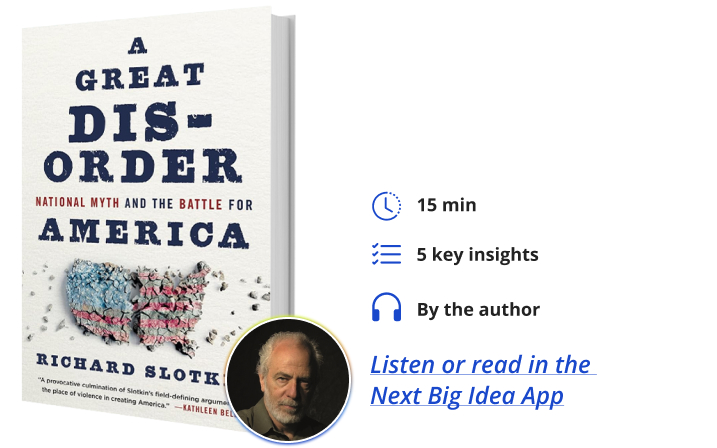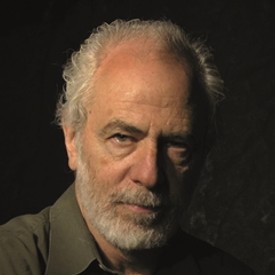Richard Slotkin is a historian of American culture and author. He is the Olin Professor of English and American Studies, Emeritus at Wesleyan University since 2010. He is also a member of the American Academy of Arts and Sciences.
Below, Richard shares five key insights from his new book, A Great Disorder: National Myth and the Battle for America. Listen to the audio version—read by Richard himself—in the Next Big Idea App.

1. National myths are essential to the culture that supports a nation-state.
We are born to our families and home communities. We must learn to see ourselves as members of a national community, who have a shared history. Myths are the traditional stories through which that history is remembered and communicated.
National myths are developed over generations through every medium of cultural expression: histories, textbooks, newspapers, sermons, political speeches, popular literature, and movies. They tell us who can share American identity and what the purposes of our government should be.
They also enable us to turn history into an instrument of political power. In any major crisis, one of our cultural reflexes is to scan our memory archives, our lexicon of myths, for analogies that will help us interpret the crisis, and precedents on which to model an action-script for dealing with it. When President Bush compared 9/11 to Pearl Harbor he was invoking the Myth of the Good War, and the public was prepared for the war that would follow. When a January 6th rioter yelled “It’s 1776” he was framing his insurrection as a repetition of the American Revolution.
Four mythologies have been central to the development of American nationality:
- The Myth of the Frontier is our oldest myth. It traces our cultural origin to the savage racial wars of settlers and Indigenous peoples and our phenomenal economic growth to the exploitation of abundant natural resources.
- The Myth of the Founding deals with the establishment of national independence and the twin pillars of our national creed: the revolutionary principles of the Declaration of Independence and the limited government structures of the Constitution.
- The Myth of the Civil War arose from the existential crisis that overtook the nation in the 1860s over slavery and Southern secession. It has three variants: the Liberation Myth, centered on Lincoln and the “new birth of freedom” produced by emancipation; the White Reunion Myth, which emphasizes the post-war coming together of Whites from North and South; and the Lost Cause Myth, which sanctifies the Confederate cause and the post-war struggle to restore White supremacy in the South.
- Finally, the Myth of the Good War emerged in the 1940s as the nation, for the first time, embraced its racial and ethnic diversity to unite its people in a struggle for the Free World.
The irony and peril of our situation is that the myths that have traditionally united Americans have become the slogans of a cultural civil war. On the Right is the “Make America Great Again” or MAGA movement—on the Left is a “Blue” coalition of liberals, moderates, and progressives. Each appeals to a different version of American history and of the stories through which we have remembered that history.
2. Three of these myths are central to the MAGA movement.
The flags flown by the rioters who stormed the Capitol on January 6, 2021 bore symbols of the myths that shape their consciousness. The classic “Betsy Ross” flag, with its circle of thirteen stars, and the “Gadsden Flag,” yellow with a coiled rattlesnake and the motto “Don’t Tread on Me,” invoke the Myth of the Founding. These flags identified the rioters as Revolutionary patriots.
Cowboy and coonskin hats and gun rights banners evoke the Myth of the Frontier. Its symbolism sanctifies its assertion of American exceptionalism, its laissez-faire economics, its commitment to the unregulated exploitation of natural resources, its glorification of racial conflict, and its vigilante code of justice.
“These flags identified the rioters as Revolutionary patriots.”
The “Stars and Bars” flag invokes the Lost Cause Myth, which is central to MAGA’s racial symbolism and its political action script. The 19th-century proponents of the Lost Cause asserted that racial equality and political liberalism threatened civilization itself; therefore, the most extreme measures were justified to restore White supremacy, including segregation, lynching, and one-party rule.
Donald Trump’s calls for “retribution” and rooting out “communists, Marxists, fascists and the radical left thugs and vermin within the confines of our country” are straight out of the Lost Cause playbook. Destroying the so-called vermin “allows for the termination of all rules, regulations, and articles, even those found in the Constitution.”
In all of these MAGA myths, the action script calls for political violence.
3. MAGA’s rationale for political violence becomes clear when we focus on its incorporation of the gun rights movement.
This movement uses a version of the Myth of the Founding that justifies anti-government and vigilante violence. The gun rights movement has adopted the so-called “palladium” or “insurrectionary theory” of the Second Amendment, first set forth by Supreme Court Justice Joseph Story in 1833. It holds that the Second Amendment authorizes states to form militias so they can deter or resist any tendency to tyranny by the central government.
During the 1980s and 90s, this doctrine was altered by New Right ideologists into a new rationale for anti-government action. Where Story vested the right of resistance in well-regulated state militias, exponents of the New Right assert it as the right of private individuals and unofficial paramilitary associations. NRA spokesman Fred Romero made the point explicit in 1991: “The Second Amendment is there as a balance of power. It is literally a loaded gun in the hands of the people held to the heads of government.”
By the end of President Clinton’s administration, the NRA had made its interpretation of gun rights an integral part of the conservative “culture war” agenda. By the start of President Obama’s second term, calls for political violence became applause lines at Republican rallies. Armed men appeared at public meetings, calling for “Second Amendment Remedies” to overturn the Affordable Care Act.
The logical consequences of the insurrectionary theory became visible on January 6, 2021, when a mob supported by paramilitary organizations stormed the Capitol to prevent the peaceful transfer of power. In that scene, the action scripts of the Myth of the Founding and the Lost Cause came together.
When we analyze MAGA’s use of myth, we can see that it has developed a distinctly American approach to fascism: more neo-Confederate than neo-Nazi, combining American exceptionalism, racial and ethnic bigotry, political violence, Christian nationalism, and neoliberal economics. Its myths energize the movement’s followers by giving them the sense of riding a wave of historical destiny.
4. Since the 1970s, the left and center-left have lacked a version of national myth that would similarly root their programs in historical tradition, and offer a clear vision of future destiny.
In the 2020 presidential campaign, the Blue coalition highlighted two historical narratives that had not hitherto functioned as national myths: the New Deal and the Civil Rights Movement. The New Deal, as such, has never produced the kind of sustained story-telling that characterizes national myths. Its principles were subsumed in the Good War Myth, which identified the war effort with a fight for social justice, but its own storylines, such as the struggle of labor unions against corporate power, were never developed in popular culture. The Civil Rights Movement became the myth of choice for identity-based advocacy, emphasizing minority rights, ethnic identity, and greater “diversity” in all institutions. It was also associated with a radical critique of America’s national history of racial injustice and Indigenous dispossession.
The New Deal and the Civil Rights Movement symbolize the ideological split that has divided liberal politics since the 1970s. The policy program adopted by the Biden administration attempts to integrate them. It invokes New Deal symbolism to highlight the centrality of labor and makes reform of labor-capital relations the core of the political agenda. It invokes the Civil Rights Movement in framing its approach to voting rights and equity in the distribution of federal benefits. Its cultural program is nationalistic in insisting that reform depends on the patriotic solidarity of Americans—an echo of the Good War Myth.
“The New Deal and the Civil Rights Movement symbolize the ideological split that has divided liberal politics since the 1970s.”
The Blue coalition has also drawn on traditional national myth in its invocation of Lincoln and the Emancipation version of the Civil War—most notably in its support for removing Confederate monuments and renaming military bases named for Rebel generals. The project was not only embraced by liberals, but by commanders of the armed forces. In the war of symbols, it represented a direct repudiation of the Lost Cause Myth favored by MAGA and provoked a strident reaction from then-President Trump. Later, state governments opposed history courses that addressed issues of slavery and race as so-called “critical race theory.”
The basic elements of a “Blue” national myth are in place, tracing a path from Lincoln’s “new birth of freedom” and Reconstruction to the New Deal’s grand but imperfect project of economic and social reform to the triumphs of the Good War, Great Society, and the Civil Rights Movement. If such a myth were to become popular, it would provide the left and center-left with something it has lacked since the 1970s: a narrative that roots its ideology and political program in history.
But would such a myth provide the basis for an inclusive concept of American nationality? Or would it only provide the Blue coalition with greater ideological coherence in its ongoing struggle against MAGA?
5. The passions and beliefs that divide the American public are deeply rooted in our history.
The election of 2024 is seen as an existential crisis for American democracy. Supporters of the Blue coalition point to Donald Trump’s authoritarian intentions and racist rhetoric. MAGA advocates see diversity and cultural liberalism as a menace to Christian civilization. Outright civil war is unlikely. But with the government deadlocked, and politics increasingly tribal, we face the likelihood of a “culture war-between-the-states.”
Red and Blue legislatures are adopting different laws on such fundamental structures as voting rights, gun rights, health care, abortion, and sexuality—and antithetical ways of telling and teaching the American story. We are, therefore, in danger of losing the sense of common nationality without which no nation-state can successfully function.
To listen to the audio version read by author Richard Slotkin, download the Next Big Idea App today:































